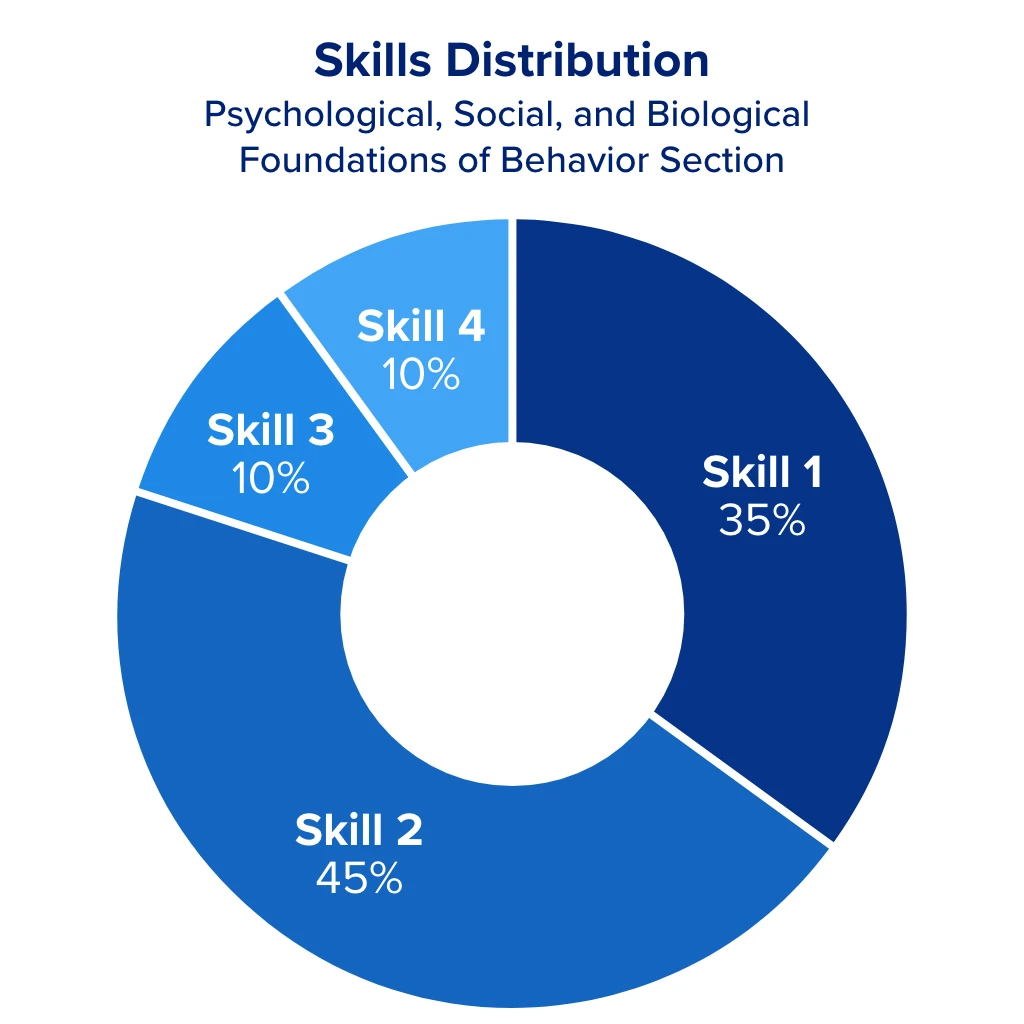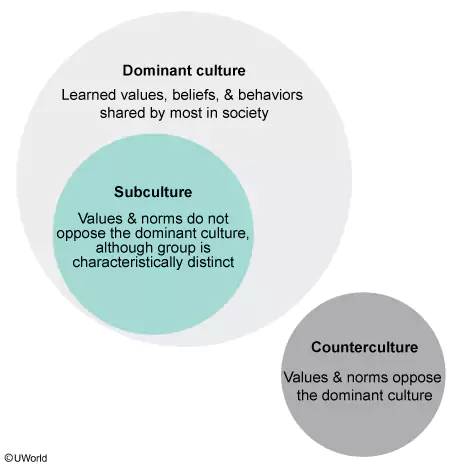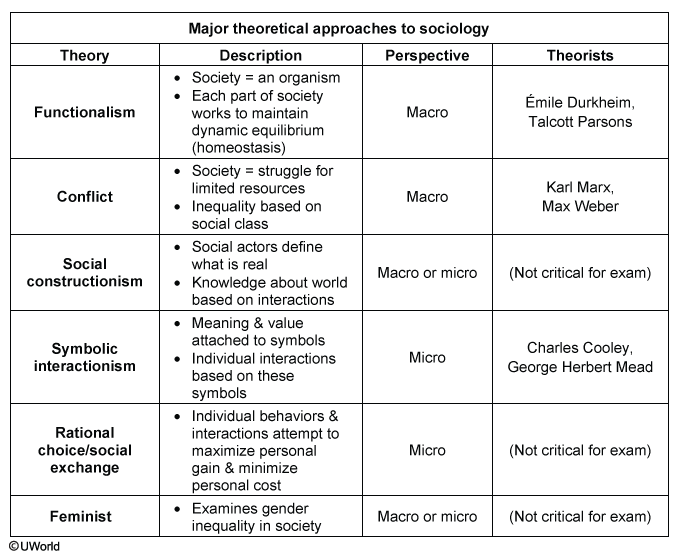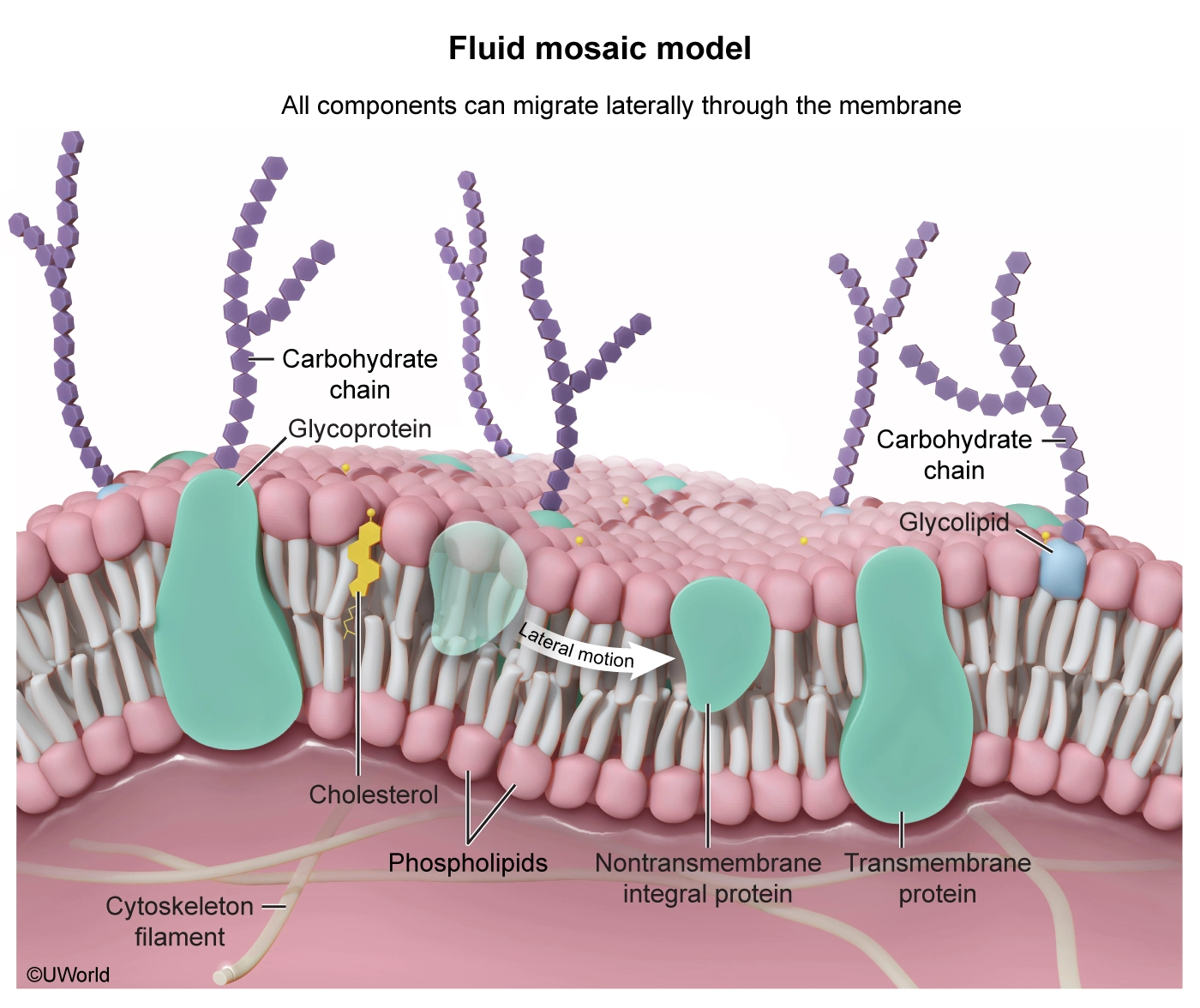MCAT® Psychology and Sociology
Topics, Practice Questions, and Study Strategies

The Psychological, Social, and Biological Foundations of Behavior section of the MCAT examines your ability to comprehend how psychological, social, and biological elements impact one's perception and response to the world. According to the AAMC, this section asks you to answer passage-based questions “by combining your knowledge of foundational concepts with your scientific inquiry and reasoning skills.”
For everything you need to know about how to get a top score on the MCAT and the Psychological, Social, and Biological Foundations of Behavior (Psych/Soc) section, check out our in-depth summary of the section's three disciplines, five foundational concepts, and four examined skills. Since the behavioral science section makes up 25% of your total MCAT score, we've included practice questions and study strategies to help you succeed.
Psychological, Social, and Biological Foundations of Behavior Section Overview
The Psychology and Sociology section of the MCAT tests your understanding of research methodologies and psychological and sociological principles and your ability to apply this knowledge to data sets, charts, and figures that summarize the research.
This table outlines the disciplines, foundational concepts, and examined skills on the exam. Note: The examined skills are the four types of questions you will find in the behavioral science section, including Knowledge of Scientific Concepts and Principals, Scientific Reasoning and Problem-Solving, Reasoning About the Design and Execution of Research, and Data-Based and Statistical Reasoning.
| # Questions & Type | 59 Multiple-Choice Questions (Passage-Based) |
| Time Allotted | 95 Minutes |
| Disciplines |
|
| Foundational Concepts |
|
| Examined Skills |
|
MCAT Behavioral Science Topics
The three main disciplines covered in the Psychology and Sociology section include Psychology (65% of Psych/Soc section), Introductory Sociology (30%), and Introductory Biology (5%). Within the three disciplines, there are five foundational concepts identified by the AAMC, Foundational Concepts 6-10. Each of the Foundational Concepts includes one to three psychological and sociological content categories that are outlined below.
Foundational Concept 6
Factors That Influence Perception, Thoughts and Reactions
Foundational Concept 6 focuses on biology, psychology, and sociology subjects and how individuals perceive and respond to the world around them and tests these content categories:
- Sensing the environment
- Areas to study tested in this category include Neuroanatomy, Regions of the Eye, Regions of the Ear, and Signal Detection Theory and Weber’s Law.
- Making sense of the environment
- Areas to study tested in this category include Operant Conditioning, Piaget’s Theory of Cognitive Development, Vygotsky’s Zone of Proximal Development, and Terms related to Memory and Learning such as Trial and Error, Algorithms, Deductive Reasoning, and Inductive Reasoning.
- Responding to the world
- Areas to study tested in this category include Operant Conditioning, Classical Conditioning, Arousal Theory, General Adaptation Syndrome, psychological disorders, and different social attachment styles, including Avoidant and Secure Attachment.
Foundational Concept 7
Factors That Influence Behaviour and Behaviour Change
Foundational Concept 7 focuses on individual and social determinants of behavior and behavior change and tests these content categories:
- Individual influences on behavior
- Areas to study tested in this category include Symbolic Interactionism, Bystander Effect, Socioeconomic Status, and Primary and Secondary Stressors.
- Social processes that influence human behavior
- Areas to study tested in this category Groupthink, Conformity, Stigma, Compliance, and Group Polarization. Sociological processes are tested in this category rather than psychological since sociology pertains more to social behavior.
- Attitude and behavior change
- Areas to study tested in this category include Different Components of Attitude, Cognitive Dissonance, and The Elaboration Likelihood Model as a couple of examples.
Foundational Concept 8
Factors That Influence Perceptions and Interactions
Foundational Concept 8 focuses on factors that influence perceptions and interactions and tests these content categories:
- Self-identity
- Areas to study tested in this category include Freud’s Stages of Development, Erikson’s Stages of Psychosocial Development, the Psychoanalytic Perspective, and the Humanistic Perspective.
- Social thinking
- Areas to study tested in this category include Conflict Theory, Functionalism, Symbolic Interactionism, and Social Constructionism
- Social interactions
- Areas to study in this category include Social Class, Power, and Social Stratification.
Foundational Concept 9
Cultural and Social Factors That Influence Well-Being
Foundational Concept 9 focuses on the social variables and processes that influence our lives and tests these content categories:
- Understanding social structure
- Areas to study and society structure models tested in this category include Conflict Theory, Functionalism, Social Constructionism, Material Culture, and Symbolic Culture.
- Demographic characteristics and processes
- Areas to study tested in this category include Demographic Transition, Migration, Ethnographics, and terms related to Epidemiology.
Foundational Concept 10
Social stratification and access to resources influence well-being
Foundational Concept 10 focuses on how social inequality affects how we interact with one another and its influence on health and the healthcare system and tests the following content categories:
- Inequality of Space, Social Class and Health Inequalities
- Areas to study tested in the “Social Inequality” concept include: Social Stratification, Poverty, Social Capital, Class, Power, and Social Reproduction.

What are the MCAT skills tested on Psych/Soc questions on the MCAT?
The psychology, sociology and biological foundations section of the MCAT tests you on four different core skills outlined below.
Skill 1 requires examinees to:
- Demonstrate their understanding of scientific concepts and principles
- Identify the relationships between closely related concepts
These questions ask you to recognize, identify, recall, or define concepts in the natural, behavioral, and social sciences, and their relation to one another.
Skill 2 requires examinees to:
- Reason about scientific principles, theories, and models
- Analyze and evaluate scientific explanations and predictions
These questions ask you to use scientific knowledge to solve problems in the natural, behavioral, and social sciences.
Skill 3 requires examinees to:
- Demonstrate an understanding of important components of scientific research
- Reason about ethical issues in research
These questions ask you to display your scientific inquiry skills by “doing” science. You must understand scientific methodology and demonstrate your knowledge of the ways natural, behavioral, and social scientists conduct research.
Skill 4 requires examinees to:
- Interpret patterns in data presented in tables, figures, and graphs
- Reason about data and draw conclusions from it
These questions ask you to display your ability to “do” science through data-based and statistical-reasoning skills. You will need to be able to read and interpret results in tables, graphs, and charts, identify patterns in data, and draw conclusions from provided evidence.
MCAT Psychology and Sociology Sample Questions and Answers
The following MCAT psychology and sociology questions and explanations were pulled from our MCAT QBank to highlight how UWorld can help you raise your score. Read each practice question carefully and submit your answers to view detailed rationales.
Religion establishes the beliefs and rituals surrounding the sacred and provides meaning and significance to individuals’ lives. The tenets of any given religion can have a far-reaching impact on the individuals within its faith community. For example, certain religions promote faith-based lifestyle directives (FBLDs), which urge believers to follow specific guidelines regarding their own behavior (eg, restrictions on diet and substance use) and their treatment of others (eg, mission work). Because these practices typically reflect the religious group’s values, FBLDs are often an important expression of faith for the deeply religious.
One religious group with health-related FBLDs is the Seventh Day Adventist Church, which formed in the 1860s after early leaders broke away from established Protestant churches. Since its formal establishment, Seventh Day Adventist Church membership has grown from 3,500 to over 20 million worldwide. The Seventh Day Adventist Church advocates conservative religious teachings and a holistic approach to health and wellness; members are encouraged to pursue vegetarianism, exercise regularly, and avoid alcohol and tobacco.
Although FBLDs impact believers’ personal choices and behaviors, they are also often meant to have an impact on others through the creation of social institutions such as schools and hospitals. For example, early Adventist leaders developed a health care system to serve the needs of the larger community, and members of the modern Adventist Church have continued to try to reduce health disparities worldwide by creating hospitals, clinics, and universities that provide health care and education services to underserved and developing communities.
Researchers from a variety of fields have examined health-related religious values and FBLDs. Epidemiological research has shown that believers from different religions who follow certain FBLDs (eg, abstaining from smoking and alcohol) experience lower rates of chronic illnesses (eg, heart disease and many types of cancer) than the general population. Sociologists have suggested that as a society increasingly relies on medical professionals, rather than clergy, as legitimate sources of guidance on lifestyle behaviors, membership in religious groups with values that are compatible with medicalization will continue to rise. Some hypothesize that this phenomenon accounts for the seemingly contradictory increase in membership in certain conservative religious groups with strict FBLDs, despite mainstream society becoming less religious.
The sects and churches with FBLDs described in the passage are most likely to be categorized as:
| A. | countercultures, because members’ values and norms oppose those of mainstream society. | ||
| B. | utilitarian organizations, because membership is voluntary and based on shared values. | ||
| C. | subcultures, because members’ values and norms are distinct from mainstream society. | ||
| D. | aggregates, because membership is based on a sense of unity and identification with the group. |
Religious organizations can be categorized as churches, sects, and cults.
- Churches are established formal organizations that tend to be well integrated into society.
- Sects are formed after believers split from an established church, often in pursuit of a more pure or traditional form of faith.
- Cults are radical groups of believers organized around a charismatic leader.
The dominant culture includes the established set of norms, values, and beliefs that define a society. A subculture is a group of individuals who are characteristically distinct from the dominant culture, but whose values and norms still generally align with the dominant culture.
The sects and churches described in the passage have values and norms (eg, FBLDs) that differ somewhat (ie, are distinctive) from mainstream society, but that are not opposed to it; therefore, they would best be categorized as subcultures.
(Choice A) A counterculture opposes and rejects the norms/values of the dominant culture (eg, much of the antiwar movement of the 1960s). The sects and churches described in the passage are distinct from mainstream culture, but there is no indication that they are opposed to it, making them subcultures, not countercultures.
(Choice B) Utilitarian organizations compensate members for their involvement (eg, money, certification/diploma). The sects and churches described in the passage could be considered normative organizations (ie, membership based on shared values), not utilitarian organizations.
(Choice D) An aggregate is a collection of individuals who share a common location but do not identify as a group (eg, all the people at a given store at 11:00 AM). The sects and churches described in the passage could be considered in-groups (ie, groups to which members identify and belong), not aggregates.
Educational objective:
A subculture is distinct from the dominant culture but is still aligned with the general norms and values of the dominant culture.
Based on the passage, which statement is most consistent with a symbolic interactionist perspective?
| A. | The definition for what is sacred may differ depending on the religion. | ||
| B. | Dynamic equilibrium is maintained when social control gradually shifts from religion to medicine. | ||
| C. | Individuals create meaning through serving others in faith-based mission work. | ||
| D. | Some religious groups attempt to reduce health care disparities that stem from class inequalities. |
Symbolic interactionism is a micro-sociological perspective concerned with the interpersonal interactions through which the subjective meanings that shape social reality are developed. Subjective meanings differ by context and culture (eg, avoiding eye contact is a sign of respect in Japan but is considered rude in the US) and can change over time.
The statement that individuals create meaning through serving (ie, interacting with) others in faith-based mission work is most consistent with symbolic interactionism. Under the symbolic interactionist perspective, mission work may become a meaningful expression and symbol of a believer’s faith.
(Choice A) Social constructionism suggests that reality is created through shared meanings and definitions arising from social interactions. A definition for what is sacred that depends on the religion reflects a perspective that is most consistent with social constructionism (not symbolic interactionism).
(Choice B) Structural functionalism emphasizes how social structures maintain dynamic equilibrium (ie, homeostasis) in society. The maintenance of dynamic equilibrium through the gradual shifting of social control from religion to medicine reflects a functionalist (not symbolic interactionist) perspective.
(Choice D) Conflict theory focuses on how inequalities between social classes cause conflict. A situation in which religious groups attempt to reduce health care disparities that stem from class inequalities aligns with a conflict (not symbolic interactionist) perspective.
Educational objective:
Symbolic interactionism is a micro-sociological perspective that suggests that people develop subjective meanings for things (eg, objects, behaviors) through social interaction.
Which concept is most relevant to the hypothesis described at the end of the fourth paragraph?
| A. | Secularization | ||
| B. | Cultural transmission | ||
| C. | McDonaldization | ||
| D. | Social reproduction |
Major types of social change can affect a society’s emphasis on religion:
- Modernization refers to the social progress and transition of a society brought about by industrialization. This process results in a society becoming less traditional and more bureaucratized, with a reduction in the importance of religion.
- As religious involvement declines, secularization of a society occurs as religious institutions lose social and political influence.
- A reaction to secularization, fundamentalism refers to the renewed adherence to strict, traditional religious beliefs and practices by some individuals.
According to the fourth paragraph, some sociologists hypothesize that the seemingly contradictory increase in the membership of some conservative religious groups despite mainstream society becoming less religious (ie, more secularized) is occurring because the values of these religious groups are compatible with medicalization (a more secular value). Therefore, this hypothesis is most relevant to secularization.
(Choice B) Cultural transmission describes the passing of cultural elements (material, nonmaterial, or both) from one generation to the next. The contradiction described by the hypothesis is most consistent with secularization, not cultural transmission.
(Choice C) McDonaldization describes the process by which extreme efficiency and rationalization produce negative consequences in society (eg, reduced quality of products). The contradiction described by the hypothesis is most consistent with secularization, not McDonaldization.
(Choice D) Social reproduction refers to the transmission of society’s values, norms, and practices, including social inequality, from one generation to the next (eg, the child of wealthy parents tends to be wealthy as an adult). The contradiction described by the hypothesis is most consistent with secularization, not social reproduction.
Educational objective:
Modernization, the transition of a society due to industrialization, results in religion losing importance in society. Secularization refers to the diminishing social/political influence of religion in society. A reaction to secularization, fundamentalism refers to renewed adherence to strict, traditional religious beliefs/practices by some individuals.
Results from a survey of believers indicated a positive correlation between the incorporation of religion into an individual’s life and participation in FBLDs. This illustrates what type of study, and what concept was being assessed?
| A. | Observational, religious affiliation | ||
| B. | Experimental, religious affiliation | ||
| C. | Observational, religiosity | ||
| D. | Experimental, religiosity |
In sociology, there is a distinction between religiosity and religious affiliation. Religiosity refers to the extent to which a religious doctrine is internalized and incorporated into an individual’s life (eg, behaviors, beliefs). For example, Jewish individuals with a high degree of religiosity demonstrate many beliefs and behaviors that align with Judaism, and “being Jewish” is an important part of how they define themselves.
Observational studies are conducted when it is unethical or unfeasible to manipulate a variable of interest. For example, it would not be feasible (or ethical) to manipulate the degree to which religion is internalized.
Therefore, the survey findings presented are from an observational study (ie, no manipulation of variables) that assessed religiosity, the incorporation of religion into an individual’s life.
(Choices A and B) Religious affiliation describes the specific religious group to which an individual identifies, which is not synonymous with living one’s life according to the principles, behaviors, or customs of that religion. For example, one may consider oneself to be Catholic but not attend church. A study in which believers are surveyed about the incorporation of religion into their lives is assessing religiosity, not religious affiliation.
(Choices B and D) In an experimental design, the researcher manipulates independent variables to measure their effect on dependent variables. In this study, no variables were manipulated, making it an observational, not experimental, design.
Educational objective:
Religious affiliation describes an individual identifying with a specific religious group, whereas religiosity (or religiousness) is the degree to which an individual internalizes and incorporates that religion into their lives, as demonstrated by the individual’s behaviors and beliefs.
Based on information in the passage, which of the following best represents a latent function of FBLDs?
| A. | Believers incorporating FBLDs as an expression of their faith | ||
| B. | Reduction of health disparities in the community | ||
| C. | Believers founding hospitals and clinics | ||
| D. | Lower rates of chronic illnesses in believers who follow FBLDs |
Structural functionalism is a macro-sociological perspective that compares modern society to a biological organism. This theory proposes that, just as the various organ systems cooperate to maintain an organism’s homeostasis, social institutions work together in the interest of societal balance, known as dynamic equilibrium.
From the structural functionalist perspective, social institutions have manifest functions, which are expected, and latent functions, which are unintended. For example, social media allows people to keep in touch with friends and family (ie, manifest function), but police departments have used suspect’s social media profiles to gather information (ie, latent function).
The passage does not state that religions advocate FBLDs to reduce the incidence of chronic illness. Therefore, lower rates of chronic illnesses in believers are unintended, latent functions of FBLDs from the functionalism perspective.
(Choices A, B, and C) As described in the passage, the incorporation of FBLDs as an expression of believers’ faith, the founding of hospitals and clinics, and the reduction of health disparities in the community are all manifest (ie, expected) directives and consequences of religions with FBLDs and health-related values.
Educational objective:
Structural functionalism is a macro-level sociological perspective proposing that social institutions work together to maintain societal balance (dynamic equilibrium). Social institutions have manifest (intended) functions and latent (unintended) functions.
Which prediction is compatible with the sociologists’ assertion in the fourth paragraph? The increase of medicalization in society will result in medical professionals having:
| A. | greater power and authority. | ||
| B. | reduced power and authority. | ||
| C. | greater authority, but with no effect on their power. | ||
| D. | greater power, but with no effect on their authority. |
In sociology, power refers to the ability to control and influence others. Authority refers to whether others believe that the power is legitimate. There are three types of authority:
- Traditional authority comes from longstanding patterns in society (eg, a queen is seen as having legitimate power in a monarchy).
- Charismatic authority stems from the personal appeal and/or extraordinary claims of an individual (eg, Gandhi was seen as having legitimate power due to his ability to inspire people).
- Rational-legal authority arises from the professional position a person holds (eg, a physician is seen as having legitimate power due to extensive training).
Medicalization, the process of defining human behaviors or characteristics as medical conditions, often results from shifting attitudes, new scientific evidence, or new treatments. For example, menopause, a natural condition, is now viewed by some as a deficiency in hormones that can be treated with pharmaceuticals. Medicalization leads individuals to look to medical professionals as the experts in diagnosing, preventing, or treating such conditions.
As medicalization increases in a society, individuals will increasingly rely on medical professionals, rather than clergy, as legitimate sources of guidance on lifestyle behaviors. Therefore, medical professionals will have more power (ie, influence on people) and authority, as that power will be seen as legitimate.
(Choice B) Increasing medicalization will increase, not reduce, the power and authority of medical professionals.
(Choices C and D) As medicalization increases, both the power (the ability to influence people) and authority (power being perceived as legitimate) of medical professionals will increase.
Educational objective:
In sociology, power refers to the ability to influence and control others. Authority refers to whether others perceive that power as legitimate.
Psychology and Sociology Tips and Strategies
Mastering the Psych/Soc section requires not only a solid grasp of concepts but also the ability to apply it effectively. This section dives into the strategies that can elevate your performance and enhance your understanding.
Move Beyond Memorization
There's no sugarcoating it – the Psych/Soc section of the MCAT requires you to know a significant amount of content. However, it's crucial not to limit yourself to rote memorization. Instead, your goal should be to reinforce the content with relevant examples, transforming them into relatable concepts. This practice becomes invaluable when distinguishing nuanced terminologies within the exam. Having solid examples can serve as a reliable anchor, preventing confusion between seemingly similar terms that, in reality, hold distinct meanings.
Challenge Assumptions
A common misconception among students is that the Psych/Soc section of the exam is easy, and you can memorize definitions to get a top score. However, this notion has limitations. Attaining a top score in the Psych/Soc section requires critical thinking skills. You can develop your critical thinking skills by analyzing your mistakes, identifying trends, and devising an improvement plan.
Learn Study Types and Their Application
The MCAT will test you on various study types within the Psych/Soc section, such as Ethnographic Studies, Case-Control Studies, and Longitudinal Studies. Understanding how these studies can be applied to diverse scenarios mentioned in the passage is critical. Equally important is the ability to craft a well-designed experiment, which entails recognizing the characteristics of a dependent variable, an effective positive control, and potentially a mediating variable. If the concepts mentioned are unfamiliar, allocate time to review them because they will be on the exam.
Look for Keywords in the Question Stem
Look for keywords and patterns in the question stem and passage to help guide you to the correct answer. Use keywords in the question to identify evidence in the passage that supports your answer choice. If you get an answer wrong, go back to the question stem and ask yourself how the keywords in the question stem could have helped you find the correct answer choice.

Frequently Asked Questions
How many sociology questions are there on the MCAT?
The psychology, sociology, and biological foundations section includes approximately 18 sociology questions (30%) out of 59. The number of questions may vary depending on the version of the exam.
How many psychology questions are there on the MCAT?
The psychology, sociology, and biological foundations section includes approximately 38 psychology questions. Psychology questions make up 65% of the section. The number of questions may vary depending on the version fo the exam.
How do I increase my MCAT psych/soc score?
The best way to improve on the Psych/Soc section is to work through exam-like MCAT practice questions and carefully review any mistakes to strengthen your understanding. Identify the reason behind your choices and seek to understand the thought process that led you to that particular answer. Ask yourself how you can prevent the same mistake in the future. Reflect on whether you overlooked pivotal keywords in the question stem.
Some students find it helpful to log their mistakes. With the UWorld MCAT QBank, you can access an online notebook tool that facilitates note-taking during your review process. This reflective journaling will help you recognize patterns in your mistakes and improve.













